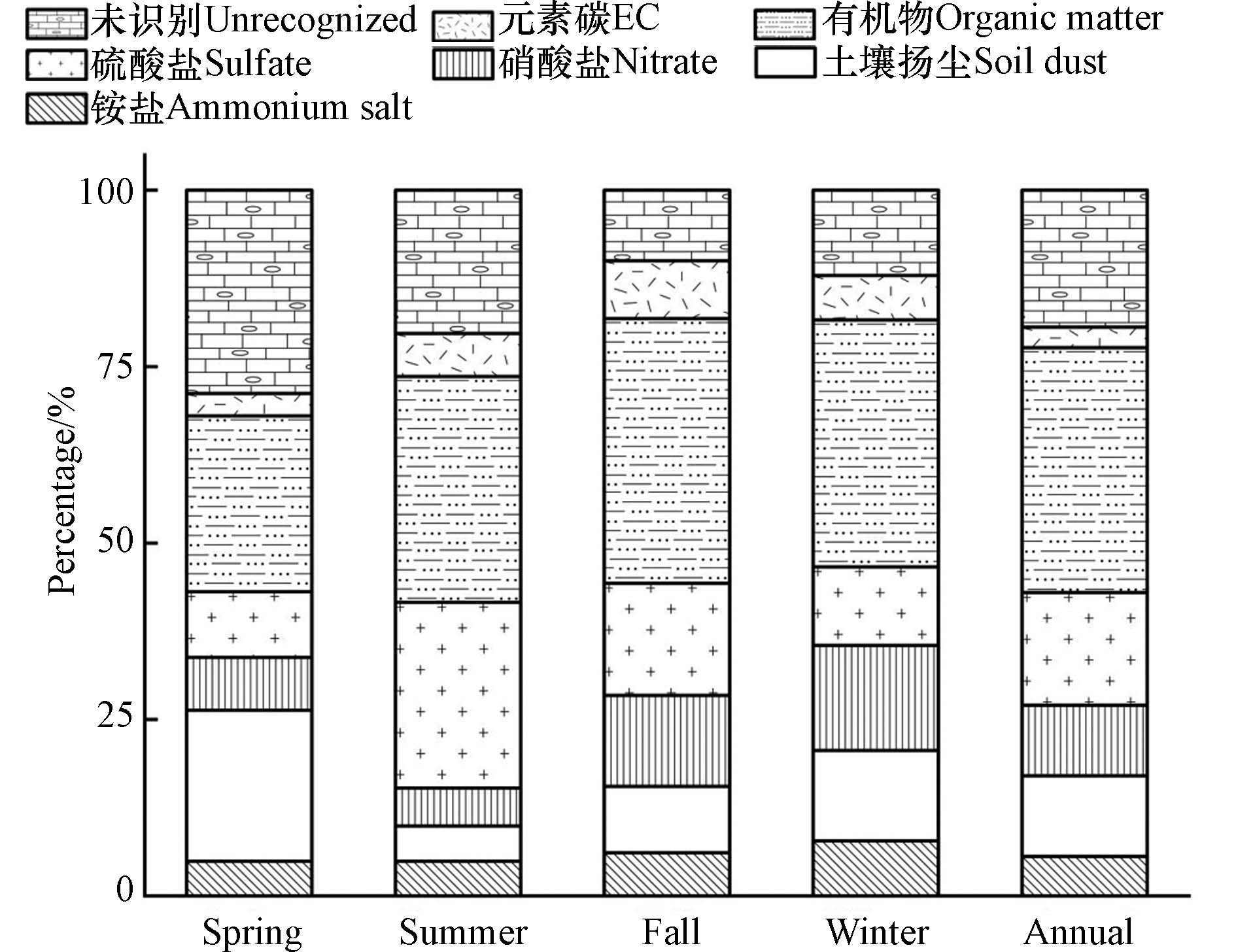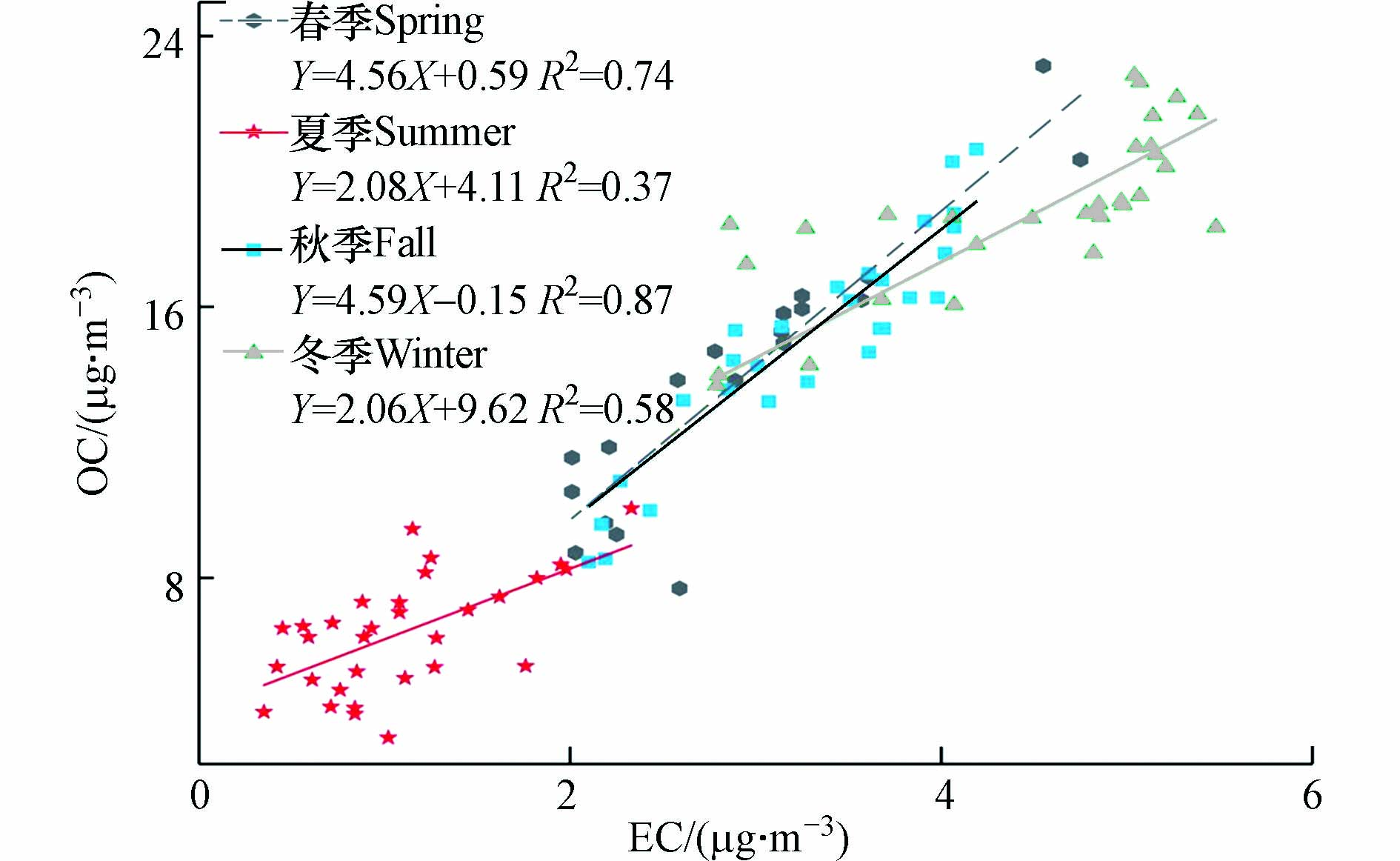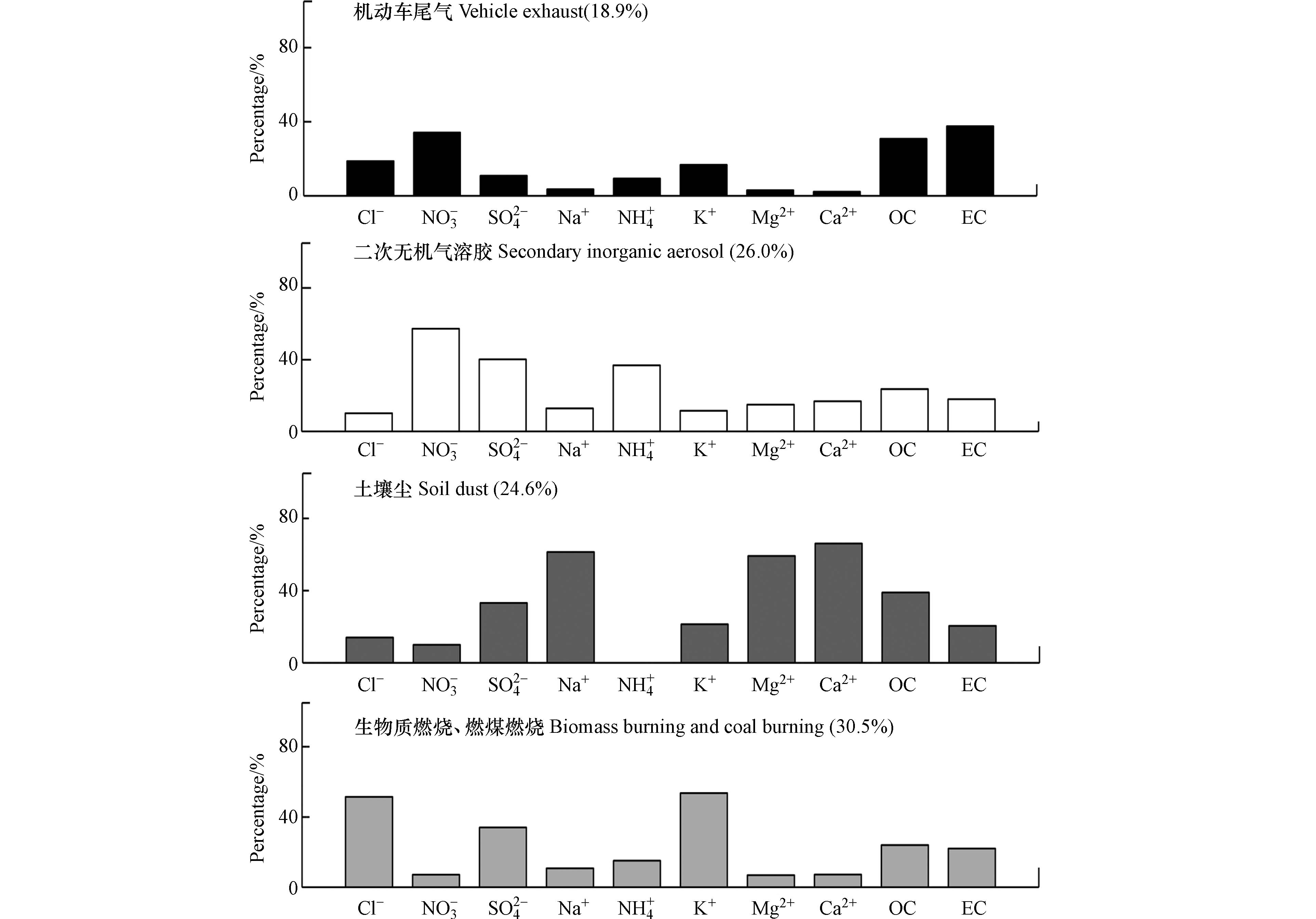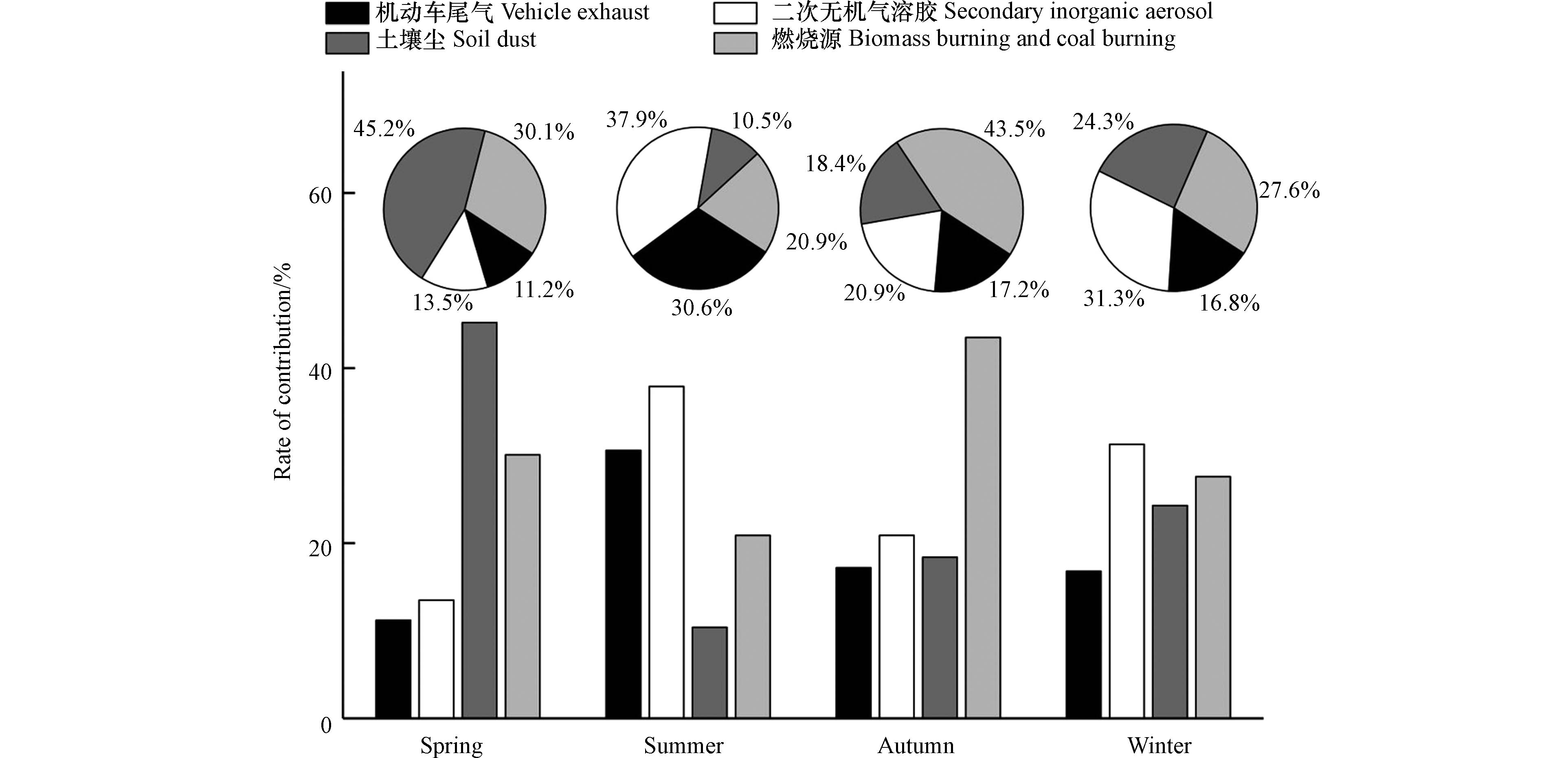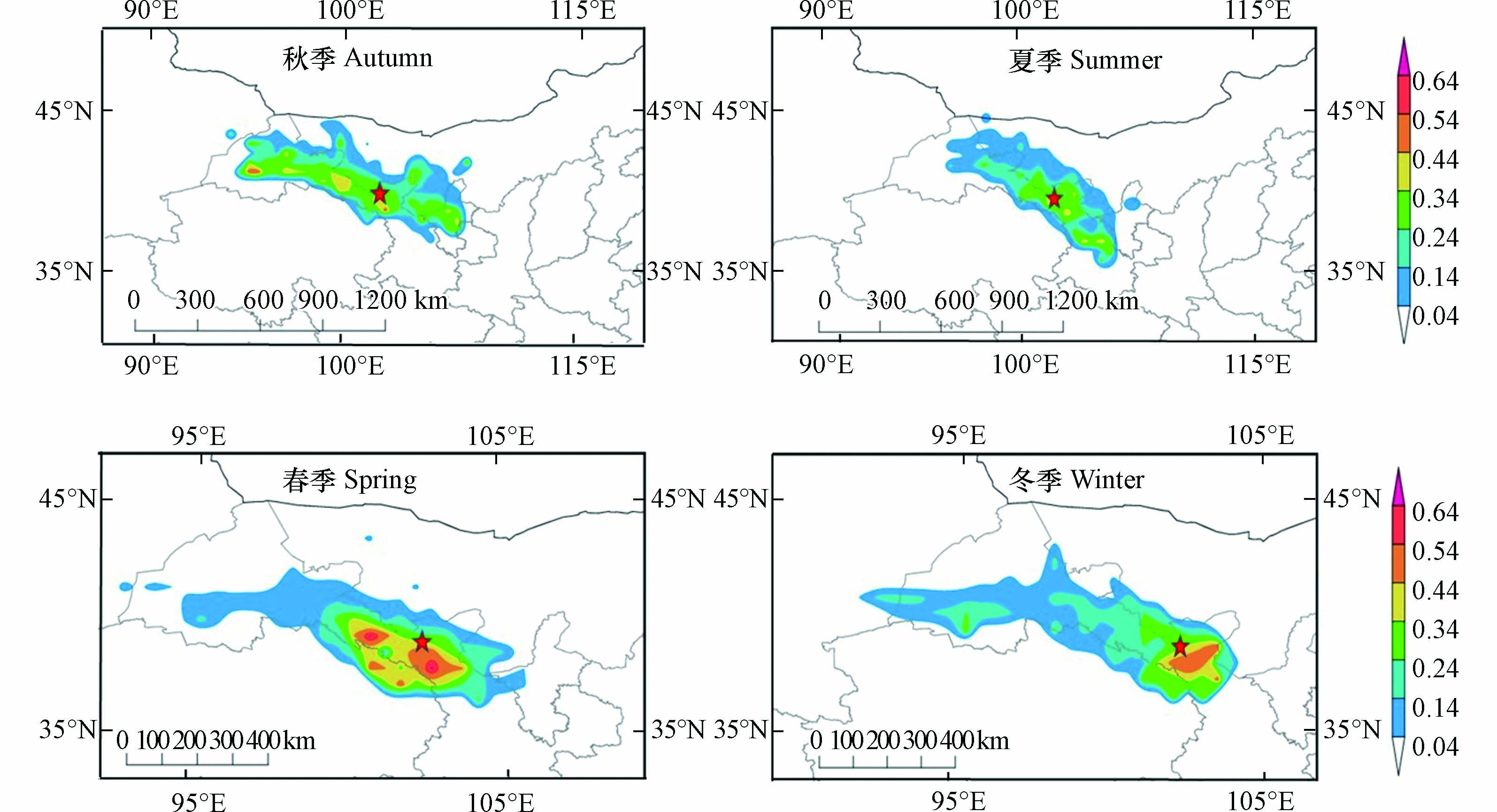-
近年来,我国发布了一系列大气污染防治政策和攻坚方案,环境空气重污染天数明显减少,空气质量状况明显改善[1],但PM2.5仍是我国大气主要的污染物,其季节性和区域性问题依旧是空气质量的主要问题[2]. 而PM2.5作为粒径小于或等于2.5 μm的颗粒物,它不仅在空气中具有滞留时间长和传输距离远等特点,它还能进入人体呼吸道深处,诱发多种疾病,对人体健康的危害极其深刻[3 − 4]. PM2.5主要的组成部分包括碳质气溶胶和水溶性离子. 碳质气溶胶主要包括有机碳(OC)和元素碳(EC),是造成灰霾现象的重要污染物[5];水溶性离子具有吸湿性和易溶于水的特性,是造成酸雨的重要原因[6].
2013年至2020年间,我国西北地区PM2.5浓度的年均下降幅度为3.9 μg·m−3,显著低于东部地区(5.3 μg·m−3)和西南地区(4.1 μg·m−3)[7],但相对于东部地区和西南地区的PM2.5研究来说,西北城市相关的研究总体较少. 目前,国内学者对西安[8]、兰州[9]、西宁[10]、酒泉[11]等西北城市的大气颗粒物开展了研究,如罗玉等[8]于2019年11月至2019年12月对陕西西安大气中PM2.5进行了在线监测,发现PM2.5年平均浓度超过了国家空气质量二级标准限值,并推测西安冬季PM2.5污染主要由机动车排放、二次污染和生物质燃烧共同贡献;蒋慧敏等[9]利用兰州市2019年夏冬两季PM2.5的观测资料对PM2.5的组分和潜在污染源进行研究,结果表明SO42−、Ca2+、NO3−、NH4+在PM2.5中含量最高,且兰州市PM2.5污染除了受本地污染源的影响外还可能受到内蒙古高原和新疆塔克拉玛干沙漠等远距离传输的影响;徐建伟等[10]对西宁2014年11月至2015年1月的PM2.5样品进行采集,分析其水溶性离子和碳质组分,研究发现SO42−、NO3−、NH4+含量较高,表现出较高的二次污染,且存在SOC污染;蒙晓瑞[11]于2019年3月至2020年1月对甘肃酒泉市大气颗粒物进行采集和研究,结果表明酒泉四季PM2.5的日浓度均超过了国家二级标准,且PM2.5污染受本地及附近区域影响较大. 但大部分西北地区的研究都是基于大气颗粒物的短期监测,对PM2.5中的碳质组分和水溶性离子的连续性监测数据仍比较有限,因此对该地区的PM2.5进行连续监测并开展相关研究,这是目前西北地区较为缺乏的.
金昌位于我国河西走廊东段,自古以来自然条件严酷、生态环境脆弱、沙尘天气多. 同时,金昌缘矿兴企、因企设市,因镍的产量丰富又被誉为“我国的镍都”[12]. 近年来,随着金昌市产业结构的调整和能源消费的增长,金昌市PM2.5的化学组分也随之发生变化. 为进一步了解金昌PM2.5的化学组分特征及其潜在污染源,本研究采集了金昌市2020年5月—2021年3月大气PM2.5的样品,分析了PM2.5中元素碳、有机碳和主要水溶性离子的季节性变化,及阴离子当量(AE)和阳离子当量(CE)的污染特征. 本研究为发现金昌市PM2.5的潜在污染源和大气复合污染的控制方案,运用HYSPLIT(后向轨迹)和PMF(正定矩阵因子分解)模型对金昌市PM2.5进行模拟研究,以期为今后金昌市PM2.5的减排管控提供思路,为西北城市的污染防治提供科学理论参考.
-
鉴于金昌市功能区分布、人口密度、地形及气象条件等因素的影响,本研究将采样点设置于金昌市金川区人和宾馆的楼顶(102°10' E, 38°31' N),如图1所示. 楼顶采样高度约21 m,无高耸的建筑群影响大气循环,视野开阔,且采样点靠近交通主干道,附近主要为住宅区、行政区和龙首山矿坑等,采样点的监测数据基本能代表金昌市的大气环境状况[13]. 同时,金昌市地处内陆腹地,面朝巴丹吉林沙漠,背靠祁连山脉,是古丝绸之路的重要节点,属大陆性温带干旱气候,海拔约1400—1600 m,光照充足,温度适宜,年平均气温约为10 ℃,温度随地形的垂直变化而呈现出北高南低的规律,四季温差大,蒸发旺盛,雨量稀少,市区年平均降水量不超过130 mm,降水量由南向北依次减少,全年多西北风,常伴沙尘天气,气候干燥[12,14].
采样时间从2020年5月至2021年3月,采样从00:00开始至23:00结束,误差≤±0.5 h,每天采样时间不少于23 h,采样基本上集中在周末进行. 去除因暴雪、强降水及设备故障等原因所导致的无效样品后,春季、夏季、秋季和冬季分别采集有效样品19、31、28、30组,全年共采集有效样品108组(同一天3台设备所采集的3个样品为一组). 采样设备为武汉天虹TH-150F型中流量颗粒物采样器(100 L·min−1),采样滤膜选用美国Whatman公司生产的石英滤膜(90 mm). 采样前,首先用丙酮擦拭已准备好的铝箔纸,然后逐一检查空白石英滤膜是否完好无损、薄厚均匀且无污染,接着将其用铝箔纸包好放入留有开口的马弗炉中烘制5 h(温度400 ℃下),以去除滤膜表面易挥发的有机质. 烘制结束后,将其放入干燥器中静置24 h以上,然后用精度为十万分之一的电子天平称量,称量结果精确到0.01 mg. 称量结束后,用铝箔纸包好放入密实袋中,最后将其放入冰箱低温保存(低于−6 ℃). 采样时,操作人员均佩戴乳胶手套和口罩,选择在无风或风小的环境中操作,避免滤膜在装卸过程中被污染. 采样后,将样品用铝箔纸封装保存,放入冰柜低温储藏,并记录采样前后的温度、天气状况、大气压、工况、标况等[9].
-
OC、EC的质量浓度选用Sunset公司生产的热光碳分析仪进行测定,同时,在每次样品检测之前都需要进行1到2次的空白膜实验,此步骤可充分燃烧该仪器中的残留气体,从而保障所得结果的准确性和稳定性. 分析时将面积为1 cm2的滤膜放入加热炉中,在无氧的纯氦(He)环境下阶段性升温,当炉内温度升高至870 ℃时,分别测出OC1、OC2、OC3和OC4,部分OC因焦化作用生成裂解碳OPC(Optically detected pyrolyzed carbon). 之后,当炉内温度冷却至550 ℃时,在氦气与氧气的混合气体环境(98%He + 2%O2)下程序升温,分别测出EC1、EC2、EC3. 检测过程中,由于OC焦化生成的OPC性质表现为EC的性质,最终将OC定义为(OC1+OC2+OC3+OC4+OPC),EC定义为(EC1+EC2+EC3-OPC).
水溶性离子的质量浓度在中国科学院西北生态环境资源研究院冰冻圈科学国家重点实验室内100级的超净环境中测定. 样品先通过分析天平称重后用陶瓷剪刀取1/4采样滤膜并剪碎,然后置于25 mL具塞离心管中,加入20 mL超纯水,之后用超声波振荡半小时后,将提取液离心3 min,取上清液,用0.22 μm一次性过滤头过滤最后使用离子色谱仪(Dionex-320)来检测样品中的无机离子浓度(SO42−、Ca2+、Na+、Cl−、NO3−、NH4+、Mg2+、K+)[15]. 同时为消除滤膜对实验结果所产生的影响,每次需保存3个空白滤膜样品并进行相同的空白监测,用于校正数据和减少误差.
同时,本研究从中国气象数据网(https://data.cma.cn/)获取金昌市的气象数据,其中选取2020年—2021年金昌市内气象观测站所观测的数据作为研究所需的气象资料,包括:逐日平均气温、逐日平均降水、逐日平均风速和逐日相对湿度;从金昌市环境空气质量监测公报取得研究所需的空气污染资料,包括:SO2、NO2和PM10数据.
-
由于目前还没有技术能够直接求得一次有机碳(Primary organic carbon,POC)和二次有机碳(Secondary organic carbon,SOC)的值,国内外研究通常采用EC示踪法来定量估算SOC,常采用OC、EC比值的最小值来定量估算OC中SOC的含量[16]. 考虑到气象条件和污染源排放在各季节可能存在差异,因此本研究分别以春季、夏季、秋季和冬季所得的(OC/EC)min值来计算各季节的SOC含量,计算方法如下:
式中,POC为一次有机碳的质量浓度(μg·m−3);(OC/EC)min为采样期间OC与EC之比的最小值;
$ \mathrm{S}{\text{OC}}_{\text{sec}} $ 、$ {\text{OC}}_{\text{tot}} $ 、EC分别为SOC、OC、EC的质量浓度(μg·m−3). -
空气中PM2.5的酸碱性能对大气降水的pH值产生重要影响,本研究通过各季节所采集的PM2.5样品来分析测定PM2.5中水溶性离子(阳离子:Ca2+、Na+、NH4+、Mg2+、K+;阴离子:SO42−、Cl−、NO3−)的离子平衡,其对评估PM2.5的酸碱性具有重要的作用. 其阴阳离子当量计算公式如下[17]:
-
HYSPLIT是由美国国家海洋和大气管理局(NOAA)和澳大利亚气象局(Bureau of Meteorology Australian, BOM)在过去20年联合研发的一种用于大气计算和分析大气污染输送、扩散轨迹的综合模式系统[18]. 本研究通过潜在源贡献因子法(PSCF)对金昌市不同季节的PM2.5污染物潜在来源进行分析,PSCF值可被解读为:受体点位颗粒物浓度高于所设定的阈值时,其与气团传输至该受体点时经过第ij个网格有关,也就是说,高PSCF值网格表明这些区域对受体点位颗粒物浓度有高潜在贡献. 区域内第ij个网格的PSCF值定义为[19 − 21]:
式中:在第ij个网格内经过,且到达受体点的轨迹总数称为nij;同一网格中,具有比阈值高的颗粒物浓度、也在同一时间到达受体点的轨迹数,被定义为mij.
-
PMF(正定矩阵因子分解)模型于1993年首次由赫尔辛基大学的Dr. Paatero等[22]提出,该模型具有无需事先获取详细的源成分谱、对因子分解矩阵进行非负约束、可较好处理缺失及不精确的数据等特点,已被广泛应用于大气颗粒物源解析的研究中[23]. PMF模型不需要污染源的成分谱信息,只需输入各组分浓度及其不确定度即可. PMF算法以B(污染源载荷)和L(源廓线)中元素非负为约束条件,通过加权最小二乘法使得Q达到最小为最优,进而求解B和L. 设C为h×s 矩阵,h为样品数,s为污染物组分,那么C可分解为C=BL+T,其中B为h×r矩阵,L为r×s矩阵,r为主要污染源的数目,T为残数矩阵,PMF计算公式如下[24]:
式中:
$ {C}_{ij} $ 表示i样品中j组分的浓度;bik是第k个源对第i个样品的相对贡献;lkj是第k个排放源中j组分的含量;tij是残差;uij是第i个样品中第j个化合物的不确定度. 可以看出不确定度对Q的值起至关重要的作用,不确定度由下式求得[25]:式中:MDL为仪器检出限,Error fraction为不确定度比例系数,conc.为组分浓度.
-
PM2.5化学质量闭合研究(ACMC)是将重构得到的气溶胶质量与其称重质量相比较,以验证PM2.5化学组分分析的全面性和称量结果的准确性[26]. 采样滤膜经称量后,根据石英滤膜在采样前后的质量及标准状态下的采样体积可计算出PM2.5的质量浓度,计算公式如下[11]:
式中,ρ为PM2.5浓度;W2为采样后滤膜浓度;W1为采样前滤膜浓度;V为标准状态下的采样体积.
根据化学分析测试的结果来加合PM2.5的化学组分成分又能得到PM2.5的构建质量. 按有机物(OM)、元素碳(EC)、二次水溶性离子(NH4+、NO3−、SO42−)、土壤扬尘几类物质对PM2.5的进行重构,其具体计算如下[26]:
式中,因本研究的采样点位于金昌城区,而城市采样点从有机碳到有机物的转换系数一般选择1.6[27].
-
在观测期间金昌市PM2.5质量浓度范围为(5—842) μg·m−3,年均值为(62.2±10.4) μg·m−3,该均值是《环境空气质量标准》(GB 3095-2012)规定的二级年标准限值(35 μg·m−3)的1.8倍,高于金昌国控点以往的观测值(33.6 μg·m−3,2014—2018年). 将金昌市PM2.5浓度和西北地区其他城市相比,低于西安[8](78.3 μg·m−3,2019—2020年)、兰州[9](113.6 μg·m−3,2019年)、西宁[10](72.6 μg·m−3,2014—2015年);和东部沿海城市相比,高于上海[28](35.8 μg·m−3,2019年)和宁波[29](36.9 μg·m−3,2015年),低于杭州[30](84.4 μg·m−3,2013年)和南京[31](104.5 μg·m−3, 2016—2017年);和内陆其他城市相比,低于西南地区的成都[32](165.1 μg·m−3,2009—2010年)和重庆[33](76.4 μg·m−3,2014—2015年).
同时,金昌市PM2.5质量浓度还存在着显著的季节差异,其季节变化特征表现为春季(88.5 μg·m−3)>冬季(73.2 μg·m−3)>秋季(45.7 μg·m−3)>夏季(22.3 μg·m−3). 这种差异主要是由于气象因素与大气污染物浓度之间存在密切联系[34]:气温升高,污染物分子间的扩散能力增强,污染物的浓度降低[35];一般情况下,风速越大,大气污染物的水平输送和稀释扩散能力越强,但当风速增加到一定程度时,过大的风速又会致使污染物的远距离输送[36];当降水达到一定强度时,会对空气中的污染物产生湿清除的作用[36]. 金昌市采样期间PM2.5质量浓度与气象参数的季节变化特征如图2所示.
春季金昌市PM2.5质量浓度的变化区间为6—842 μg·m−3. 春季由于寒冬刚结束,土壤化冻,各种植物还未生长起来,地表大量裸露,出现持续性沙暴天气,使得PM2.5质量浓度急剧增加,对比同期可吸入颗粒物(PM10)数据可发现,春季PM10平均质量浓度为285.4 μg·m−3,该均值是PM10日平均值二级标准限值(150 μg·m−3)的1.9倍,远高于其他季节(年均值为106.3 μg·m−3). 夏季金昌市PM2.5质量浓度的变化区间为5—49 μg·m−3. 夏季因近地层空气温度高,大气对流运动强烈,风速大,致使污染物的扩散稀释速率加快,同时,7月9日—7月18日和8月14日—8月23日的连续性降水又能清除空气中的各类污染物,尤其是颗粒物. 秋季金昌市PM2.5质量浓度的变化区间为6—85 μg·m−3. 因秋季处于非风沙非采暖期,污染物减少,PM2.5浓度较低且相对稳定. 冬季金昌市PM2.5质量浓度的变化区间为6—134 μg·m−3. 污染仍较严重,可能是由于冬季较低的边界层高度,致使风速较小,从而导致污染物的输送和稀释能力降低,且冬季降水稀少(冬季降水量仅为8.6 mm)又使得污染物沉降堆积.
-
ACMC在通常情况下,参考Maenhaut等的研究方法[26],气溶胶的质量构建主要包含有机物、元素碳、二次水溶性离子、土壤扬尘、无机元素. 在本项研究中,因缺乏无机元素资料,故未采用地壳元素,而采用Ca2+的含量来估算土壤扬尘对PM2.5的贡献量[27],并且在构建质量闭合时将无机元素归为“未识别”(构建质量浓度与称重质量浓度之间的浓度差)[37]. 在构建气溶胶化学质量时,其不确定度不仅与仪器分析误差有关,还与所选着的经验公式有关,而从有机碳到有机物(Organic matter, OM)估算偏差的不确定度最大,本研究的采样点位于金昌城区,而城市点的转换系数一般选择1.6[27]. 具体结果见图3.
从全年变化来看,碳质组分(OM+EC)是金昌PM2.5的主要组成部分,贡献率达34.7%,其次为二次离子(24.8%) . 从各季节来看,土壤扬尘在春季和冬季显示出较高的贡献率,分别为21.4%、12.8%,这可以理解为春冬季属于沙尘期;除春季外,二次离子对PM2.5的贡献率较为稳定,均在30%左右;“未识别”值在春季显示出最大值(28.8%),最低值出现在秋季(10.0%). 出现较高的“未识别”贡献率,主要有两方面的原因:一方面由于本研究将无机元素归为“未识别”;另一方面可能是由于在重构PM2.5质量时,颗粒物吸附的水分(不包括土壤中某些硅酸盐所带的结晶水)往往不被考虑,而二次离子又具有吸湿性,这往往会对构建的颗粒物化学质量引入一定的数据偏差. 之前的研究中也曾出现过利用石英滤膜采集的样品在进行质量重建研究时,存在称量质量与构建质量之间较高浓度差的情况,如:2015年北京质量重建研究有40%的质量浓度差[38].
-
在2020年5月—2021年3月采样期间共采集有效大气样品108组. 观测期间金昌市PM2.5中OC、EC年平均质量浓度分别为(13.4±5.6) μg·m−3和(2.9±1.5) μg·m−3,总碳(TC=OC+EC)占PM2.5质量浓度的16.27%,表明碳质气溶胶是金昌市大气PM2.5的重要组分. 表1列出了金昌市四季PM2.5中OC、EC、TC、SOC的平均质量浓度及OC/EC、SOC/OC的平均值.
由于不同季节的气候条件和污染来源有所差异,金昌市四季OC和EC的季节变化特征表现为:冬季>秋季>春季>夏季. 其中,TC质量浓度在冬季显示出最高值,达22.8 μg·m−3,可能是由于冬季降水稀少、稳定的大气层结和较低的混合层高度综合影响使得污染物难以向外扩散,更易于聚集和滞留[39];而TC浓度在夏季显示出最低值为7.4 μg·m−3,首先是因为夏季受风沙和供暖的影响较弱,其次夏季降水集中,对污染物浓度又起到了稀释作用.
同时,将金昌和国内其他城市相比(表2),发现OC、EC质量浓度低于蒋慧敏等[9]在2019年观测的兰州数值,低于吴明等[40]在2017年观测的成都数值,远高于Mamoudou等[41]在上海洋山港观测的数值,OC质量浓度与贺瑶等[31]、张婷婷等[42]在南京、北京的观测值相当. 将金昌和已有研究相比,无论是OC、EC的质量浓度还是TC在PM2.5中的含量均高于黄菊[43]在2018年的观测结果,一定程度上说明金昌碳质气溶胶污染问题日益突出,亟需加大力度治理.
-
OC、EC主要来源于燃煤燃烧、机动车尾气排放和生物质燃烧等过程[43]. OC主要代表大气颗粒物中的有机物成分,是一种含有上百种有机化合物的混合体[44],其可以是直接排放的一次有机碳(POC)也可以是大气挥发性有机物经光化学反应所产生的二次有机碳(SOC)[45 − 47]. EC只存在于一次气溶胶中,主要是不完全燃烧过程的产物且具有高稳定性特征. 一般采用OC与EC的比值法来简单判断是否有SOC的生成[31]. 并且当其比值大于2时,认为大气中存在二次污染[48]. 从测定结果(表1)可以看出,金昌四季OC/EC均大于2,表明在采样期间均存在二次有机碳污染. 考虑到SOC在不同季节可能存在气象条件和污染源排放不同等因素的影响,例如:降水对OC的清除效率高于EC,OC在高温高湿和强太阳辐射的状态下易转化为SOC,因此本研究采用OC与EC比值的最小值来定量估算OC中SOC的含量不同季节的SOC含量. 金昌的SOC/OC的季节分布特征为春季(19.3%)、夏季(46.3%)、秋季(15.5%)、冬季(32.8%),而对应的SOC浓度为3.1 μg·m−3、2.9 μg·m−3、2.8 μg·m−3、6.1 μg·m−3. 冬季SOC质量浓度较高,可能是由于金昌冬季供暖等原因致使大气中一次碳污染物和有机气体的含量上升,且冬季降水少又为SOC的生成创造了条件. 而SOC浓度较低的夏季,在OC中占比却最高,原因可能由于夏季光照强、大气活性高有利于光化学反应的发生;另一方面可能与高温高湿的气候条件有关,在2020年夏季监测期间,平均气温(18.5 ℃)远高于年平均值(7.8 ℃)而降水量(69.7 mm)占年降水量的57%,导致二次有机反应更加活跃.
有学者提出仅通过OC/EC值的大小来分析是否存在二次污染不够充分,而通过OC与EC的相关系数可在一定程度上反应颗粒物碳组分的来源是否具有统一性[40]. 并且,OC与EC的可决系数越大,相关性越强,进而得出两者的污染来源具有一致性,即SOC在OC中占比更小,POC在OC中占比更大[41]. 金昌市不同季节PM2.5中OC与EC的相关性如图4所示。
由图4可以看出,金昌四季OC与EC之间的相关性均表现为正相关关系,且OC与EC相关性的季节分布特征由高到低依次为秋季(R2=0.87)、春季(R2=0.74)、冬季(R2=0.58)、夏季(R2=0.37). 秋季OC与EC的相关性显示出最高值,R2=0.88,说明OC与EC的同源性好,可能存在相似污染源,这与秋季SOC在OC中占比最低的结论相一致,秋季处于非采暖非风沙期,污染物来源相对单一. 春冬两季次之,R2=0.74、R2=0.58,污染源较秋季复杂,可能是在每年春耕之际焚烧秸秆的现象时有发生,致使春季除了受沙尘影响外,还受生物质燃烧的影响,而冬季既属于采暖期又属于沙尘期,OC与EC的相关性差. 夏季OC与EC的相关系数最低,R2=0.37,说明金昌夏季OC与EC的污染来源较其他季节更为复杂,夏季日照充足,温度高,二次转化剧烈,且夏季光化学反应主要生成SOC,导致夏季OC与EC之间的相关系数最低,这与夏季SOC在OC中占比最高的结论相一致.
-
根据冰冻圈科学国家重点实验室的分析结果可知,PM2.5中总水溶性离子的年平均质量浓度为(25.0±11.6) μg·m−3,占PM2.5质量浓度的40.2%,其中,SO42−、Ca2+、NO3−、Cl−是金昌市主要的4种离子,分别占总离子的22.5%、17.1%、16.8%和12.1%. 金昌市各季节PM2.5中水溶性离子浓度及其占比的季节变化序列见图5.
在春季采样期间,总水溶性离子的平均质量浓度为27.1 μg·m−3,各离子的平均质量浓度由高到低依次为Ca2+、Na+、SO42−、Cl−、NO3−、NH4+、Mg2+、K+;占总水溶性离子的质量分数依次为24.3%、19.8%、17.6%、11.9%、9.3%、7.0%、5.3%、4.8%. 其中,Ca2+、Na+的占比高于其他离子,Ca2+是地壳元素的代表,主要来源于土壤和扬尘[40,49],而Na+是典型的海源型离子,但金昌深居内陆,对于内陆地区的Na+主要来源于工业或地面扬尘[40]. 因此,在春季采样期间Ca2+、Na+的质量浓度较高是由于频发的沙暴天气.
在夏季采样期间,总水溶性离子的平均质量浓度为12.7 μg·m−3,各离子的平均质量浓度由高到低依次为SO42−、Ca2+、Na+、Cl−、NO3−、NH4+、Mg2+、K+;占总水溶性离子的质量分数分别为45.6%、17.3%、16.0%、8.4%、5.6%、3.2%、2.9%、1.0%. 其中,SO42−的是含量最高的离子,可能原因是SO2在大气中的均相和非均相氧化反应是SO42−的重要来源,夏季平均气温达18.5 ℃高于年均值(7.8 ℃),高温和强太阳辐射天气为SO2向SO42−转化创造了有利条件[50].
在秋季采样期间,总水溶性离子的平均质量浓度为22.9 μg·m−3,各离子的平均质量浓度由高到低依次为Cl−、NO3−、SO42−、Ca2+、NH4+、Na+、K+、Mg2+;占总水溶性离子的质量分数依次为21.9%、20.5%、20.2%、12.4%、11.8%、8.5%、2.8%、2.0%. 其中,Cl−、NO3−和SO42−的含量较大,三者之合的质量分数达62.6%. Cl−不仅来源于燃煤燃烧、生物质燃烧、土壤尘,Cl−还是海盐源的标志物[51];NO3−和SO42−分别是由气态前体物NOX和SO2经二次转化生成的,两者化学特征相似,且具有共同的污染来源,主要为工业排放、人为排放(汽车尾气)、煤炭等燃料燃烧等,因此Cl−、NO3−和SO42−可能主要来源于燃煤排放.
在冬季采样期间,总水溶性离子的平均质量浓度为37.3 μg·m−3,各离子的平均质量浓度由高到低依次为NO3−、SO42−、Cl−、Ca2+、NH4+、Na+、K+、Mg2+;占总水溶性离子的质量分数依次为24.0%、19.3%、15.0%、14.4%、13.4%、9.8%、2.1%、2.0%. 其中,NO3−的占比高于其他离子,这可能是由于以挥发性组分为主的颗粒态NO3−对环境温度和相对湿度更为敏感[52]. 夏季高温利于颗粒态硝酸盐向气态转化,而冬季低温利于气相硝酸盐向固相转化[53],结合气象数据可知,冬季平均气温为-6.9 ℃远低于年均值(7.8 ℃). 同时,冬季平均相对湿度达45%,高于年均值39%,高湿环境也为NO2向硝酸盐转化提供了条件[52],从而使得NO3−的浓度增加. 此外,NO3−、SO42−、Cl−、Ca2+是冬季含量最高的四种离子,说明冬季水溶性离子还受燃煤排放和土壤尘的影响.
综上所述,金昌市四季PM2.5中水溶性离子的浓度主要受主要受燃烧源(燃煤、生物质燃烧等)、二次无机源以及土壤和扬尘源的影响.
-
对金昌市四季水溶性离子中阴阳离子组分做离子平衡分析,根据当量浓度所计算的阴阳离子当量值来绘制阴阳离子相关性曲线,如图6所示. 夏季(R2=0.73)、秋季(R2=0.84)和冬季(R2=0.94)阴阳离子的相关性较好,说明没有重要的离子缺失. 根据阴阳离子平衡方程可知,夏季、秋季及冬季的斜率依次为:1.31、1.03、1.17,AE/CE均大于1,说明阳离子相对亏损,离子整体偏酸性,即PM2.5酸性相对较强. 春季阴阳离子相关系数较差(R2=0.37),斜率K=0.52,远小于1,说明有重要阴离子缺失,也就是说金昌市春季大气PM2.5组分偏碱性.
经过分析可知,在夏季、秋季、冬季由机动车、工厂等排放的大量SO2、NOX会提高大气中气态前体物浓度,且其二次反应速率与温度、相对湿度的相关性显著,从而导致较高的SO42−和NO3−质量浓度,另外,因燃煤燃烧、生物质燃烧和土壤尘等排放的Cl−质量浓度本身就比较高,尽管土壤扬尘产生的Na+和Ca2+等阳离子的相对含量较高,但也不能完全中和掉高浓度的阴离子,使得阴离子在颗粒物中有盈余,从而导致夏秋冬三季PM2.5组分整体偏酸性[54]. 而春季因太阳辐射逐渐增强、冬季里控制北方地区的蒙古冷高压减弱,南方副热带高压开始缓慢北移,导致地表受热增加,外加土壤化冻,地表大量裸露,便造成大风沙尘天气频繁,使得Ca2+、Na+、Mg2+的含量较高,且春季SO2和NO2等气态前体物的平均质量浓度分别为11.2 μg·m−3、9.4 μg·m−3,均低于年均值(16.8 μg·m−3、15.3 μg·m−3),经过二次反应所生成的硫酸盐和硝酸盐的浓度较低,因此春季阳离子有盈余,使得金昌市春季PM2.5组分整体偏碱性.
-
在PMF模型的计算中,为确定因子的数量,依次尝试了2至9个因子,进行了多次优化运算,最终确定4个因子能合理解释其污染源类别,且此时解析结果稳定、大部分残差值分布在−3和+3之间. 进一步在−5至+5之间调整Fpeak值的变化对解析结果并无明显影响,故选择Fpeak=0时PMF的解析结果进行分析. 图7为PMF模型解析得出的金昌市PM2.5中不同污染来源的成分谱图及其贡献率占比,主要有机动车尾气、二次无机气溶胶、土壤尘、燃烧源(生物质+燃煤)四类污染源,对大气PM2.5的平均贡献率分别为18.9%、26.0%、24.6%、30.5%. 其中,燃烧源(生物质+燃煤)的贡献位居前列. 同时,图8为PMF模型解析得出的金昌市PM2.5中各季节的平均贡献率. 其中,春季土壤尘的贡献位居前列;夏季和冬季二次无机气溶胶的贡献最大;秋季最主要的贡献源是燃烧源.
因子一中载荷较高的组分有EC、NO3−、OC,其贡献率分别为37.6%、34.1%、30.8%. 氮氧化物是汽车尾气的主要排放物,其在有利的气象条件下经二次反应最终形成NO3−;燃料在机动车引擎的高温燃烧下可释放出大量的OC和EC,接着它们通过尾气排放在大气中进行转化[35],因此该因子较符合为机动车尾气排放的特征. 源解析结果表明,该因子对金昌市大气PM2.5的贡献率为18.9%,其贡献率在夏季显示出最高值,这可能由于夏季较集中的降水能够稀释扬尘的浓度,同时夏季处于非沙尘非采暖期受燃煤等化石燃料排放的影响较少,从而突出了机动车尾气排放的影响.
因子二中贡献率最高的是NO3−,达57.3%,其次为SO42−、NH4+,其贡献率分别为40.2%、36.9%. 研究表明,NH4+、NO3−和SO42−均是气态前体物经过一系列化学反应转化而生成的,且硫酸盐、硝酸盐、铵盐是组成二次无机气溶胶(Secondary inorganic aerosol,SNA)的主要离子. 其中,NH4+的气态前体物为NH3;NO3−的气态前体物为NO2、NO3等氮氧化物;SO42−的气态前体物为SO2等含硫气体[55]. 因此将因子二定义为二次无机气溶胶,其对大气PM2.5的贡献率为26.0%,且夏冬两季的贡献率(平均值为34.6%)明显高于春秋两季(17.2%),这可能由于夏冬季的气象条件更易于气态前体物在大气中的二次反应. 夏季较高的气温和相对湿度有利于硫酸盐的积累[56 − 57],而冬季因低温与降水稀少等气象条件为硝酸盐的生成创造了条件[58],进而导致夏冬季的贡献率较高.
因子三识别为土壤尘,其对金昌市大气PM2.5的贡献率为24.6%,该因子中Ca2+、Na+、Mg2+的贡献率较高,分别为66.1%、61.4%、59.2%. Na+的主要来源为海盐离子、盐碱地和道路尘[30],金昌深居内陆,来自海盐的概率不高,Mg2+和Ca2+均为地壳元素的标志物[59]. 在春季观测期间该因子的贡献率达45.2%,远高于其他季节(平均值为25.0%). 这可能是因为金昌市地处西北干旱区,降水稀少,地表疏松,土壤贫瘠,植被存活率低;且春季多大风,四季温差大,这样的自然环境特点势必会导致土壤尘的污染. 同时,近年来金昌市金川区因过度开采地下水,致使土壤盐碱化和次生盐渍化的扩散与蔓延,进而导致金昌受土壤尘的影响较重.
因子四中K+、Cl−、SO42−的贡献率较高,分别为53.6%、51.5%、34.0%,其次为OC、EC. EC主要是不完全燃烧过程的产物,如:木材燃烧、生物质燃烧和燃煤排放等;K+是生物质燃烧典型的示踪物,此外生物质的燃烧还会产生较多的OC[51];Cl−源于燃煤燃烧、生物质燃烧;SO42−是由气态前体物(SO2等含硫气体)经过一系列化学反应转化而成,而燃煤电厂湿法脱硫可以在一定程度上增加大气中SO2的含量[55]. 因此将因子四定义为燃烧源(生物质+燃煤),其对金昌市大气PM2.5的贡献率最高,达30.5%. 这是由于金昌作为典型的资源性工矿城市,早已形成以重工业为主体的产业结构体系,加之近年来矿石产量逐年上升,致使因工业排放而引发的大气污染问题严重. 同时,在每年春季在播种之前和秋季秋收之后,村民会将地里的秸秆焚烧处理,此过程势必会加剧金昌市的大气污染.
-
利用TrajStat软件对金昌市的采样点(38.53°N, 102.19°E)进行后向轨迹模拟,模拟起始高度设置距离地面500 m,采用全球资料同化系统数据(GDAS)计算2020年5月—2021年3月逐日到达受点金昌市的72 h后向气流轨迹,并且起始时间设置为每日06:00(北京时间). 同时,将金昌市采样期间的大气PM2.5浓度高时间分辨的连续观测数据添加入气团运动轨迹,将重污染轨迹阈值设定为各季节的平均值:春季(88.5 μg·m−3)、夏季(22.3 μg·m−3)、秋季(45.7 μg·m−3)、冬季(73.2 μg·m−3),通过潜在污染源贡献法(PSCF)对PM2.5的潜在源区及其贡献进行分析,计算结果如图9.
从图9中可以看出,金昌市四季大气PM2.5的潜在污染源分布的主要区域相似,均集中在我国河西走廊一带(嘉峪关、张掖、金昌、武威),但对受点污染值的贡献程度却差异明显,季节变化显著. 春季处于大气环流调整期,多大风天气,致使PSCF高值范围分布最广、最为集中且贡献最为显著,污染贡献较大的区域集中在受点附近的区域:武威和张掖. 冬季PSCF高值和高值范围大大缩小,仅集中在武威. 再次为秋季,夏季最小甚至没有.
结合大气气团潜在污染源贡献分析以及金昌大气PM2.5浓度高时间分辨的连续观测数据可知,2020年5月—2021年3月金昌大气PM2.5浓度在春季受外来污染源输入影响较大,其他三季存在外来污染源输入的影响,但从潜在污染源贡献因子来看,PSCF值整体较低. 说明金昌市春季大气PM2.5浓度受外来输入影响较大,而外来污染源输送对夏季、秋季和冬季大气PM2.5浓度的影响有限,应主要考虑本地排放的贡献.
-
(1)2020年5月—2021年3月采样期间,金昌市PM2.5的年平均质量浓度为(62.2±10.4) μg·m−3,ACMC研究表明碳质组分(OM+EC)是金昌市大气PM2.5的重要组分. PM2.5中OC、EC质量浓度的年平均值分别为(13.4±5.6) μg·m−3、(2.9±1.5) μg·m−3,二者之和TC占PM2.5质量浓度的16.3%,通过计算OC、EC的比值,又可推断出观测期间存在较高的二次污染并伴随着较多的SOC生成.
(2)Ca2+、SO42−、Cl−、NO3−分别是金昌市春季、夏季、秋季、冬季大气PM2.5中最主要的水溶性离子,表明观测期间金昌市PM2.5中水溶性离子的浓度主要受燃烧源(燃煤+生物质)、二次无机源以及土壤和扬尘源的影响. 根据阴阳离子平衡方程可知,夏季、秋季和冬季大气PM2.5水溶性离子整体偏酸性,春季整体偏碱性.
(3)PMF模型结果显示:金昌市四季大气PM2.5中颗粒物组分的主要来源为土壤尘、二次无机气溶胶、机动车尾气和燃烧源(生物质+燃煤). 其中,燃烧源(生物质+燃煤)的贡献位居前列. 大气气团潜在源贡献分析结果显示:金昌市春季大气PM2.5浓度受外来污染源影响较大,其他三季外来污染源输入影响有限,应主要考虑本地排放的贡献.
金昌市PM2.5的化学组分特征及来源分析
Chemical component characteristics and source analysis of PM2.5 in Jinchang City
-
摘要: 为研究金昌市PM2.5及其化学组分(有机碳、元素碳和水溶性离子)的特征,于2020年5月—2021年3月对金昌市大气PM2.5进行手工采样,并运用PMF模型和HYSPLIT模型解析污染来源. 研究结果表明,观测期间金昌市PM2.5年平均质量浓度为(62.2±10.4) μg·m−3,各季节平均质量浓度由高到低依次为春季、冬季、秋季、夏季. 化学质量闭合研究表明:碳质组分(OM+EC)是金昌PM2.5的主要组成部分. PM2.5中的OC与EC的年平均质量浓度分别为(13.4±5.6) μg·m−3、(2.9±1.5) μg·m−3,TC占PM2.5质量浓度的16.3%,并且四季OC/EC的平均值均大于2,表明采样期间各个季节均存在二次污染. 夏季OC与EC之间的相关系数最低,说明夏季污染物来源较其他季节更为复杂. 金昌市PM2.5中总水溶性离子的年平均质量浓度为(25.0±11.6) μg·m−3,占PM2.5质量浓度的40.2%,其中,SO42−、Ca2+、NO3−和Cl−是金昌市主要的4种离子,分别占总离子的22.5%、17.1%、16.8%、12.1%. 对水溶性离子做离子平衡分析表明:夏季、秋季和冬季阴阳离子的相关性较好,没有重要的离子缺失,春季较差,有重要阴离子缺失. PMF模型表明金昌市PM2.5的主要污染源为燃烧源(生物质+燃煤)(30.5%)、土壤尘(24.6%)、二次无机气溶胶(26.0%)和机动车尾气(18.9%),HYSPLIT模型表明金昌市春季PM2.5浓度受外来污染源输入影响较大,夏季、秋季和冬季应主要考虑本地排放的贡献.Abstract: In order to study the characteristics of PM2.5 and its chemical components (organic carbon, elemental carbon and water-soluble ions) in Jinchang City, manual sampling of atmospheric PM2.5 in Jinchang City was conducted from May 2020 to March 2021, and the PMF model and HYSPLIT model were used to analyze the sources of pollution. The results showed that the annual average mass concentration of PM2.5 was (62.2±10.4) μg·m−3 in Jinchang during the observation period, and the average mass concentration of PM2.5 was in spring, winter, autumn and summer from high to low. The chemical mass closure study shows that the carbon component (OM+EC) is the main component of PM2.5 in Jinchang. The average annual mass concentrations of OC and EC in PM2.5 were (13.4±5.6) μg·m−3 and (2.9±1.5) μg·m−3, respectively. TC accounted for 16.3% of PM2.5 mass concentration, and the average values of OC/EC in four seasons were greater than 2, indicating that secondary pollution existed in each season during the sampling period. The correlation coefficient between OC and EC in summer was the lowest, indicating that the pollutant sources in summer were more complex than in other seasons. The average annual mass concentration of total water-soluble ions in PM2.5 in Jinchang City is (25.0±11.6) μg·m−3, accounting for 40.2% of PM2.5 mass concentration, in which SO42−、Ca2+、NO3− and Cl− are the four main ions. They accounted for 22.5%, 17.1%, 16.8% and 12.1% of total ions respectively. The ion balance analysis of water-soluble ions showed that the correlation of canion in summer, autumn and winter was good, and there was no important ion deletion, while in spring it was poor, and there was important anion deletion. The PMF model showed that the main pollution sources of PM2.5 in Jinchang were combustion sources (biomass + coal)(34.4%), soil dust (25.2%), secondary inorganic aerosol (22.6%) and motor vehicle exhaust (18.0%). The HYSPLIT model showed that the PM2.5 concentration in Jinchang in spring was greatly affected by the input of external pollution sources. Summer, autumn and winter should mainly consider the contribution of local emissions.
-
Key words:
- PM2.5 /
- chemical composition /
- source analysis /
- Jinchang City.
-

-
表 1 采样期间OC、EC、TC、SOC的平均质量浓度和OC/EC、SOC/OC的平均值
Table 1. The average mass concentration of OC, EC, TC, SOC and the average value of OC/EC, SOC/OC during the sampling period
季节
Season组数
Sample numberOC/(μg·m−3) EC/(μg·m−3) TC/(μg·m−3) OC/EC平均值
AverageSOC/(μg·m−3) SOC/OC/% 春季
Spring19 14.0±5.1 3±0.9 16.9±5.9 4.8±0.9 3.1±2.8 19.3% 夏季
Summer31 6.4±1.9 1.1±0.6 7.4±2.4 3.8±0.6 2.9±1.3 46.3% 秋季
Fall28 15.0±4.4 3.3±0.7 18.2±5 4.6±0.7 2.8±2.5 15.5% 冬季
Winter30 18.6±2.7 4.4±0.9 22.8±3.6 4.3±0.4 6.1±1.1 32.8% 表 2 国内不同地区PM2.5中OC、EC的质量浓度
Table 2. Mass concentration of OC and EC in PM2.5 in different areas of China
城市
City采样时间
Day数量
QuantityPM2.5/(μg·m−3) OC/(μg·m−3) EC/(μg·m−3) 文献
Reference西北地区
Northwest area金昌 2020/05—2021/03 108 62.2 13.41 2.92 本研究 西安 2019/10—2020/03 37 78.3 — — [8] 西宁 2014/11—2015/01 41 72.6 19.27 4.09 [10] 兰州 2019/01—2019/07 48 113.6 19.6 6.48 [9] 东部沿海地区
Eastern coastal area上海洋山港 2018 — 44 0.4 0.6 [41] 宁波 2015 — 36.9 — — [29] 杭州 2012/12—2013/11 181 84.4 — — [30] 南京 2016/12—2017/01 32 104.5 11.8 8.2 [31] 西南地区
Southwest area成都 2009—2010 121 165.1 22.6 9.0 [32] 重庆 2014/07—2015/05 120 76.4 22.6 9.0 [33] “—”无数据 -
[1] 姜华, 高健, 李红, 等. 我国大气污染协同防控理论框架初探[J]. 环境科学研究, 2022, 35(3): 601-610. JIANG H, GAO J, LI H, et al. Preliminary research on theoretical framework of cooperative control of air pollution in China[J]. Research of Environmental Sciences, 2022, 35(3): 601-610 (in Chinese).
[2] 陆香怡. 基于城市空气质量数据的中国绿色发展成效评价[J]. 中国统计, 2021(6): 33-36. LU X Y. Evaluation of green development effect in China based on urban air quality data[J]. China Statistics, 2021(6): 33-36 (in Chinese).
[3] 刁刘丽, 李森, 刘保双, 等. 驻马店市区采暖季PM2.5时间和空间来源解析研究[J]. 环境科学研究, 2021, 34(1): 79-91. DIAO LL, LI S, LIU B S, et al. Temporal and spatial source apportionment during the heating period Zhumadian[J]. Research of Environmental Sciences, 2021, 34(1): 79-91 (in Chinese).
[4] 刘笑杰, 王丽丽, 何博汶, 等. 长江经济带PM2.5时空演变及影响因素分析[J]. 长江流域资源与环境, 2022, 31(3): 647-658. LIU X J, WANG L L, HE B W, et al. Spatiotemporal evolution and drivers of PM2.5 in the Yangtze River economic belt[J]. Resources and Environment in the Yangtze Basin, 2022, 31(3): 647-658 (in Chinese).
[5] 沈嵩, 刘蕾, 温维, 等. 北京及周边地区夏季PM2.5中含碳组分污染特征与来源解析[J]. 环境工程, 2022, 40(2): 71-80. SHEN S, LIN L, WEN W, et al. Pollution characterization and source analysis of carbon components of PM2.5 in Beijing and surrounding areas in summer[J]. Environmental Engineering, 2022, 40(2): 71-80 (in Chinese).
[6] 张扬, 王红磊, 刘安康, 等. 南京市不同天气过程下颗粒物中水溶性离子分布特征及其来源解析[J]. 环境科学, 2021, 42(2): 564-573. ZHANG Y, WANG H L, LIU A, et al. Distribution characteristics and source analysis of Water-soluble ions in particulate matter under different weather processes in Nanjing[J]. Environmental Science, 2021, 42(2): 564-573 (in Chinese).
[7] 唐贵谦, 刘钰婷, 高文康, 等. 警惕大气污染和碳排放向西北迁移[J]. 中国科学院院刊, 2022, 37(2): 230-237. TANG G Q, LIU Y T, GAO W K, et al. Alert to the migration of air pollution and carbon emission to northwest China[J]. Bulletin of Chinese Academy of Sciences, 2022, 37(2): 230-237 (in Chinese).
[8] 王怡. 西安秋冬季PM2.5污染特征及化石燃料燃烧等源贡献演变[D]. 西安: 中国科学院地球环境研究所, 2022. WANG Y. Characteristics of PM2.5 pollution and evolution of fossil fuel combustion and other source in autumn and winter at Xi 'an[D]. Xi 'an: Institute of Earth Environment, Chinese Academy of Sciences, 2022(in Chinese).
[9] 蒋慧敏, 李忠勤, 张昕, 等. 兰州市冬夏季大气PM2.5化学组分特征及来源分析[J]. 环境科学学报, 2021, 41(5): 1690-1702. JIANG H M, LI Z Q, ZHANG X, et al. Chemical components characteristics and source analysis of PM2.5 over Lanzhou city in winter and summer[J]. Acta Scientiae Circumstantiae, 2021, 41(5): 1690-1702 (in Chinese).
[10] 徐建伟, 王晓丽, 于高峰, 等. 西宁冬季PM2.5中碳质组分与水溶性离子特征分析[J]. 环境工程, 2018, 36(8): 98-101,112. XU J W, WANG X L, YU G F, et al. Analysis of carbon components and water-soluble ions in pm2.5 of Xining during winter[J]. Environmental Engineering, 2018, 36(8): 98-101,112 (in Chinese).
[11] 蒙晓瑞. 酒泉市大气颗粒物PM10、PM2.5中无机元素污染特征研究和来源解析[D]. 兰州: 兰州交通大学, 2020. MENG X R. Pollution characteristics and source analysis of inorganic elements in atmospheric PM10 and PM2.5 in Jiuquan city[D]. Lanzhou: Lanzhou Jiatong University, 2020 (in Chinese).
[12] 李雅薇, 马利邦, 方芳, 等. 乡村人居环境质量评价及其分区治理对策研究——基于甘肃省金昌市村庄调查截面数据[J]. 湖南师范大学自然科学学报, 2022, 45(1): 20-31. doi: 10.7612/j.issn.1000-2537.2022.1.hnsfdx-zr202201003 LI Y W, MA L B, FANG F, et al. Research on the evaluation of rural human settlement quality and district governance countermeasures: based on the cross-sectional date of village survey in Jinchang city, gansu province[J]. Journal of Natural Science of Hunan Normal University, 2022, 45(1): 20-31 (in Chinese). doi: 10.7612/j.issn.1000-2537.2022.1.hnsfdx-zr202201003
[13] 王帅, 丁俊男, 王瑞斌, 等. 关于我国环境空气质量监测点位设置的思考[J]. 环境与可持续发展, 2012, 37(4): 21-25. WANG S, DING J N, WANG R B, et al. Study on the settings of ambient air quality monitoring sites in China[J]. Environment and Sustainable Development, 2012, 37(4): 21-25 (in Chinese).
[14] 李世雄. 甘肃省金昌市主要污染物以及重金属污染物环境健康风险评价[D]. 兰州: 兰州大学, 2013. LI S X. Health risk assessment of major pollutants and heavy metals in Jinchang city, Gansu Province[D]. Lanzhou: Lanzhou University, 2013 (in Chinese).
[15] 折远洋, 陈青雁, 李忠勤, 等. 甘肃南部典型城镇PM2.5浓度及水溶性离子特征分析[J]. 环境科学学报, 2022, 42(7): 53-62. SHE Y Y, CHEN Q Y, LI Z Q, et al. Characteristics of PM2.5 concentration and Water-soluble ions in the typical town of southern Gansu[J]. Acta Scientiae Circumstantiae, 2022, 42(7): 53-62 (in Chinese).
[16] 李朝阳, 袁亮, 张小玲, 等. 成都碳质气溶胶变化特征及二次有机碳的估算[J]. 中国环境科学, 2022, 42(6): 2504-2513. LI Z Y, YUAN L, ZHANG X L, et al. Characteristics of carbonaceous aerosols and estimation of secondary organic carbon in Chengdu[J]. China Environmental Science, 2022, 42(6): 2504-2513 (in Chinese).
[17] 肖德安, 徐浩, 池继松, 等. 贵阳市城区PM10和PM2.5水溶性离子特征分析[J]. 中国环境监测, 2021, 37(4): 65-74. XIAO D A, XU H, C J S, et al. Characteristics of water-soluble ions in PM10 and PM2.5 in urban areas of Guiyang City[J]. Environmental Monitoring in China, 2021, 37(4): 65-74 (in Chinese).
[18] STEIN A F, DRAXLER R R, ROLPH G D, et al. NOAA’s HYSPLIT atmospheric transport and dispersion modeling system[J]. Bulletin of the American Meteorological Society, 2015, 96(12): 2059-2077. doi: 10.1175/BAMS-D-14-00110.1 [19] 高阳, 韩永贵, 黄晓宇, 等. 基于后向轨迹模式的豫南地区冬季PM2.5来源分布及传输分析[J]. 环境科学研究, 2021, 34(3): 538-548. GAO Y, HAN Y G, HUANG X Y, et al. PM2.5 source distribution and transmission in winter in southern Henan Province based on backward trajectory model[J]. Research in Environmental Sciences, 2021, 34(3): 538-548 (in Chinese).
[20] 王郭臣, 王东启, 陈振楼. 北京冬季严重污染过程的PM2.5污染特征和输送路径及潜在源区[J]. 中国环境科学, 2016, 36(7): 1931-1937. WANG G C, WANG D Q, CHEN Z L. Characteristics and transportation pathways and potential sources of a severe PM2.5 episodes during winter in Beijing[J]. China Environmental Science, 2016, 36(7): 1931-1937 (in Chinese).
[21] 蒋轶伦, 张锋, 欧阳静静. 某钢厂大气PM2.5污染特征与潜在源区贡献分析[J]. 环境科学导刊, 2019, 38(3): 41-47,52. JIANG Y L, ZHANG F, OU Y J J. Analysis of pollution characteristics and Potential source Contribution of ambient PM2.5 in an iron and Steel Factory[J]. Environmental Science Guide, 2019, 38(3): 41-47,52 (in Chinese).
[22] PAATERO P, TAPPER U. Positive matrix factorization: A non-negative factor model with optimal utilization of error estimates of data values[J]. Environmetrics, 1994, 5(2): 111-126. doi: 10.1002/env.3170050203 [23] 李娇, 滕彦国, 吴劲, 等. 基于PMF模型及地统计法的乐安河中上游地区土壤重金属来源解析[J]. 环境科学研究, 2019, 32(6): 984-992. LI J, TENG Y G, WU J, et al. Source apportionment of soil heavy metal in the middle and upper reaches of le’an river based on PMF model and geostatistics[J]. Research of Environmental Sciences, 2019, 32(6): 984-992 (in Chinese).
[24] PAATERO P. Least squares formulation of robust non-negative factor analysis[J]. Chemometrics and Intelligent Laboratory Systems, 1997, 37(1): 23-35. doi: 10.1016/S0169-7439(96)00044-5 [25] 张夏夏, 袁自冰, 郑君瑜, 等. 大气污染物监测数据不确定度评估方法体系建立及其对PMF源解析的影响分析[J]. 环境科学学报, 2019, 39(1): 95-104. ZHANG X X, YUAN Z B, ZHENG J Y, et al. Establishment of an uncertainty assessment framework for atmospheric pollutant monitoring data and its impact on PMF source apportionment[J]. Acta Scientiae Circumstantiae, 2019, 39(1): 95-104 (in Chinese).
[26] MAENHAUT W, SCHWARZ J, CAFMEYER J, et al. Aerosol chemical mass closure during the EUROTRAC-2 AEROSOL Intercomparison 2000[J]. Nuclear Instruments and Methods in Physics Research Section B:Beam Interactions With Materials and Atoms, 2002, 189(1/2/3/4): 233-237. [27] 矫健. 我国中东部背景地区大气气溶胶PM10理化特征及来源分析[D]. 南京: 南京信息工程大学, 2021. JIAO J. The characteristics and source of PM10 at background stations of eastern China[D]. Nanjing: Nanjing University of Information Science and Technology, 2021 (in Chinese).
[28] 卢江涛, 彭章娥, 刘琳. 上海市PM2.5浓度特征及影响因素分析[J]. 应用技术学报, 2022, 22(1): 61-66. LU J T, PENG Z E, LIU L. Characteristics and influencing factors of PM2.5 concentration in Shanghai[J]. Journal of Technology, 2022, 22(1): 61-66 (in Chinese).
[29] 潘勇, 郑捷, 肖航. 长三角地区典型 PM2.5污染过程和跨区域传输对宁波污染贡献评估模拟[J]. 环境科学, 2023, 44(2): 634-645. PAN Y, ZHENG J, XIAO H. Simulation evaluation of the contribution of typical PM2.5 pollution and trans-regional transport to Ningbo pollution in the Yangtze River Delta[J]. Environmental Science, 2023, 44(2): 634-645 (in Chinese).
[30] 吴丹, 蔺少龙, 杨焕强, 等. 杭州市PM2.5中水溶性离子的污染特征及其消光贡献[J]. 环境科学, 2017, 38(7): 2656-2666. WU D, LIN S L, YANG H Q, et al. Pollution characteristics and light extinction contribution of water-soluble ions of PM2.5 in Hangzhou[J]. Environmental Science, 2017, 38(7): 2656-2666 (in Chinese).
[31] 贺瑶, 韩秀秀, 黄晓虎, 等. 南京市不同功能区冬季大气PM2.5分布特征及其来源解析[J]. 环境科学学报, 2021, 41(3): 830-841. HE Y, HAN X X, HUANG X H, et al. Distribution characteristics and source apportionment of atmospheric PM2.5 in winter season from different functional areas of Nanjing[J]. Acta Scientiae Circumstantiae, 2021, 41(3): 830-841 (in Chinese).
[32] 张智胜, 陶俊, 谢绍东, 等. 成都城区PM2.5季节污染特征及来源解析[J]. 环境科学学报, 2013, 33(11): 2947-2952. ZHANG Z S, TAO J, XIE S D, et al. Seasonal variations and source apportionment of PM2.5 at urban area of Chengdu[J]. Acta Scientiae Circumstantiae, 2013, 33(11): 2947-2952 (in Chinese).
[33] 余家燕, 王军, 许丽萍, 等. 重庆城区PM2.5化学组分特征及季节变化[J]. 环境工程学报, 2017, 11(12): 6372-6378. YU J Y, WANG J, XU L P, et al. Characteristics of chemical components of PM2.5 and its seasonal variations in Chongqing urban area[J]. Chinese Journal of Environmental Engineering, 2017, 11(12): 6372-6378 (in Chinese).
[34] 张娜, 周国富, 黄启芬, 等. 贵阳市主城区大气污染物时空分布特征及成因分析[J]. 生态科学, 2022, 41(2): 137-148. ZHANG N, ZHOU G F, HUANG Q F, et al. The temporal-spatial distribution features and cause analysis of atmospheric pollutants in Guiyang main urban area[J]. Ecological Sciences, 2022, 41(2): 137-148 (in Chinese).
[35] 张玉洁, 冯俊杰, 张武, 等. 青岛市大气颗粒物污染特征及潜在来源分析[J]. 高原气象, 2023, 42(1): 244-256. ZHANG Y J, FENG J J, ZHANG W, et al. Analysis of pollution characteristics and potential sources of atmospheric particulate matter in Qingdao[J]. Plateau Meteorology, 2023, 42(1): 244-256 (in Chinese).
[36] 王翠连, 张军, 郑瑶, 等. 郑州城区PM10、PM2.5质量浓度变化特征及其对气象因子的响应[J]. 环境保护科学, 2019, 45(6): 76-83. WANG C L, ZHANG J, ZHENG Y, et al. Variation characteristics of PM10 and PM2.5 mass concentrations and their response to meteorological factors in Zhengzhou city[J]. Environmental Protection Science, 2019, 45(6): 76-83 (in Chinese).
[37] TAO J, ZHANG L M, ENGLING G, et al. Chemical composition of PM2.5 in an urban environment in Chengdu, China: Importance of springtime dust storms and biomass burning[J]. Atmospheric Research, 2013, 122: 270-283. doi: 10.1016/j.atmosres.2012.11.004 [38] 李泓, 李广, 刘茜, 等. 北京市PM2.5质量浓度特征及组分化学质量闭合研究[J]. 中国环境监测, 2015, 31(4): 35-43. LI H, LI G, LIU Q, et al. Study on Beijing PM2.5 mass concentration characteristics and aerosol chemical mass closure[J]. Environmental Monitoring in China, 2015, 31(4): 35-43 (in Chinese).
[39] 杨磊, 陈传雷, 曹世腾, 等. 2015年11月沈阳地区一次PM2.5重污染过程综合分析[J]. 气象与环境学报, 2019, 35(3): 37-44. YANG L, CHEN C L, C S T, et al. Comprehensive analysis of a heavy PM2.5 pollution event over Shenyang in November of 2015[J]. Journal of Meteorology and Environment, 2019, 35(3): 37-44 (in Chinese).
[40] 吴明, 吴丹, 夏俊荣, 等. 成都冬季PM2.5化学组分污染特征及来源解析[J]. 环境科学, 2019, 40(1): 76-85. WU M, WU D, XIA J R, et al. Analysis of pollution characteristics and sources of PM2.5 chemical components in Chengdu in winter[J]. Environmental Science, 2019, 40(1): 76-85 (in Chinese).
[41] MAMOUDOU I, ZHANG F, CHEN Q, et al. Characteristics of PM2.5 from ship emissions and their impacts on the ambient air: A case study in Yangshan Harbor, Shanghai[J]. Science of the Total Environment, 2018, 640/641: 207-216. doi: 10.1016/j.scitotenv.2018.05.261 [42] 张婷婷, 马文林, 亓学奎, 等. 北京城区PM2.5有机碳和元素碳的污染特征及来源分析[J]. 环境化学, 2018, 37(12): 2758-2766. doi: 10.7524/j.issn.0254-6108.2018051701 ZHANG T T, MA W L, QI X K, et al. Characteristics and sources of organic carbon and element carbon in PM2.5 in the urban areas of Beijing[J]. Environmental Chemistry, 2018, 37(12): 2758-2766 (in Chinese). doi: 10.7524/j.issn.0254-6108.2018051701
[43] 黄菊. 西北典型城市大气颗粒物组分污染特征及其健康风险评估[D]. 兰州: 兰州大学, 2020. HUANG J. Pollution characteristics and health risk assessment of atmospheric particulate matter in northwest China[D]. Lanzhou: Lanzhou University, 2020 (in Chinese).
[44] 阿米拉, 耿柠波, 曹蓉, 等. 大气颗粒物中典型有机物的分析方法和污染特征研究进展[J]. 环境化学, 2021, 40(12): 3774-3786. doi: 10.7524/j.issn.0254-6108.2020081204 A M L, GENG N B, CAO R, et al. Research progress of analytical methods and pollution characteristics of typical organic pollutant in atmospheric particulate matter[J]. Environmental Chemistry, 2021, 40(12): 3774-3786 (in Chinese). doi: 10.7524/j.issn.0254-6108.2020081204
[45] HE Q S, GUO W D, ZHANG G X, et al. Characteristics and seasonal variations of carbonaceous species in PM2.5 in Taiyuan, China[J]. Atmosphere, 2015, 6(6): 850-862. doi: 10.3390/atmos6060850 [46] LI H W, WANG D F, CUI L, et al. Characteristics of atmospheric PM2.5 composition during the implementation of stringent pollution control measures in Shanghai for the 2016 G20 summit[J]. Science of the Total Environment, 2019, 648: 1121-1129. doi: 10.1016/j.scitotenv.2018.08.219 [47] TURPIN B J, CARY R A, HUNTZICKER J J. An in situ, time-resolved analyzer for aerosol organic and elemental carbon[J]. Aerosol Science and Technology, 1990, 12(1): 161-171. doi: 10.1080/02786829008959336 [48] 郭佳灵, 李友平, 刘欢, 等. 南充冬季大气PM2.5污染特征及来源分析[J]. 四川环境, 2020, 39(1): 46-54. GUO J L, LI Y P, LIU H, et al. Pollution characteristics and source apportionment of atmospheric PM2.5 in Winter of Nanchong[J]. Sichuan Environment, 2020, 39(1): 46-54 (in Chinese).
[49] 张婧伟, 杜诗文, 周雪明, 等. 淮南市不同功能区大气PM2.5的化学组分季节分布及其来源解析[J]. 安全与环境工程, 2023, 30(1): 212-220. ZHANG J W, DU S W, ZHOU X M, et al. Seasonal distribution and sources analysis of chemical components of atmospheric PM2.5 in different functional areas of Huainan City[J]. Safety and Environmental Engineering, 2023, 30(1): 212-220 (in Chinese).
[50] 毛翔, 徐立, 韩清, 等. 武汉市大气PM2.5主要水溶性离子的时空污染特征[J]. 环境卫生学杂志, 2019, 9(3): 235-241. MAO X, XU L, HAN Q, et al. Temporal and spatial pollution characteristics of main water-soluble ions of atmospheric PM2.5 in Wuhan[J]. Journal of Environmental Hygiene, 2019, 9(3): 235-241 (in Chinese).
[51] 李明燕, 杨文, 魏敏, 等. 典型沿海城市采暖期细颗粒物组分特征及来源解析[J]. 环境科学, 2020, 41(4): 1550-1560. LI M Y, YANG W, WEI M, et al. Characteristics and sources apportionment of fine particulate matter in a typical coastal city during the heating period[J]. Environmental Science, 2020, 41(4): 1550-1560 (in Chinese).
[52] 肖致美, 武婷, 卫昱婷, 等. 天津市PM2.5中二次硝酸盐形成及防控[J]. 环境科学, 2021, 42(6): 2616-2625. XIAO Z M, WU T, WEI Y T, et al. Formation and prevention of secondary nitrate in PM2.5 in Tianjin[J]. Environmental Science, 2021, 42(6): 2616-2625 (in Chinese).
[53] 李欣悦, 张凯山, 武文琪, 等. 成都市城区大气细颗粒物水溶性离子污染特征[J]. 中国环境科学, 2021, 41(1): 91-101. LI X Y, ZHANG K S, WU W Q, et al. Characterization of water-soluble ions pollution of atmospheric fine particles in Chengdu City[J]. China Environmental Science, 2021, 41(1): 91-101 (in Chinese).
[54] 任娇, 尹诗杰, 郭淑芬. 太原市大气PM2.5中水溶性离子的季节污染特征及来源分析[J]. 环境科学学报, 2020, 40(9): 3120-3130. REN J, YIN S J, GUO S F. Seasonal variation and source analysis of water-soluble ions in PM2.5 in Taiyuan[J]. Acta Scientiae Circumstantiae, 2020, 40(9): 3120-3130 (in Chinese).
[55] SONG M D, LIU X G, TAN Q W, et al. Characteristics and formation mechanism of persistent extreme haze pollution events in Chengdu, southwestern China[J]. Environmental Pollution (Barking, Essex: 1987), 2019, 251: 1-12. [56] 向欣, 张立生, 杨琨, 等. 北京市大气细颗粒物污染时空分布特征及其降水清除影响[J]. 环境污染与防治, 2022, 44(10): 1314-1317,1361. XIANG X, ZHANG L S, YANG K, et al. Spatial and temporal distribution of fine particulate matter pollution and scavenging effect on of precipitation in Beijing[J]. Environmental Pollution and Control, 2022, 44(10): 1314-1317,1361 (in Chinese).
[57] 任秀龙, 牛红亚, 李淑娇, 等. 邯郸市大气细颗粒物中水溶性离子的污染特征及来源解析[J]. 环境化学, 2021, 40(11): 3510-3519. doi: 10.7524/j.issn.0254-6108.2020070301 REN X L, NIU H Y, LI S J, et al. Pollution characteristics and source of water-soluble ions in atmospheric fine particles in Handan City[J]. Environmental Chemistry, 2021, 40(11): 3510-3519 (in Chinese). doi: 10.7524/j.issn.0254-6108.2020070301
[58] 郑敬茹, 瞿厚淑, 付山, 等. 黄石市大气PM2.5中水溶性离子浓度特征及来源分析[J]. 环境科学研究, 2019, 32(7): 1170-1178. ZHENG J R, QU H S, FU S, et al. Characteristics and source analysis of water-soluble inorganic ions in PM2.5 in Huangshi city[J]. Research of Environmental Sciences, 2019, 32(7): 1170-1178 (in Chinese).
[59] 曾兆荷, 张海潇, 赵云卿, 等. 南京北郊冬夏季大气PM2.5中水溶性有机碳的研究[J]. 环境科学学报, 2019, 39(11): 3659-3667. ZENG Z H, ZHANG H X, ZHAO Y Q, et al. The study of water-soluble organic carbon in PM2.5 during winter and summer in the northern suburb of Nanjing[J]. Acta Scientiae Circumstantiae, 2019, 39(11): 3659-3667 (in Chinese).
-



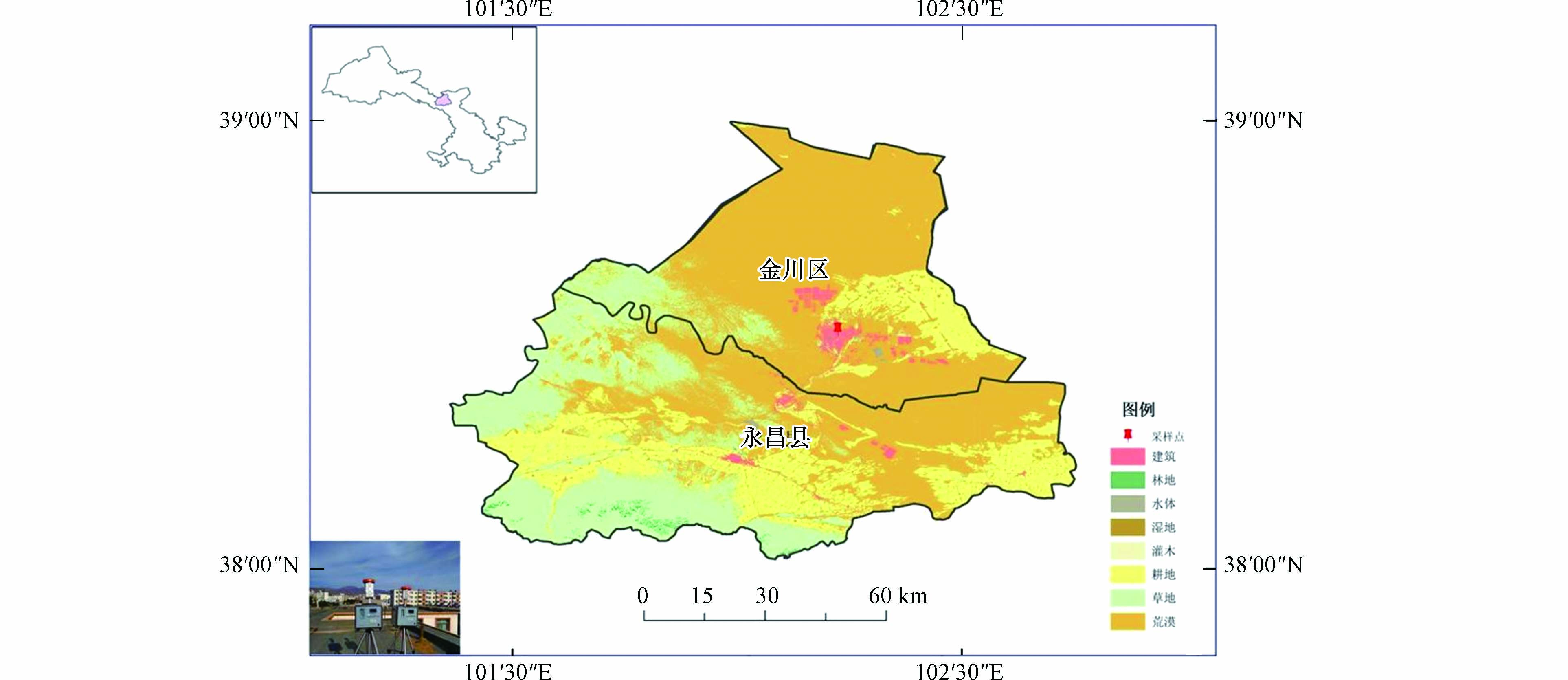
 下载:
下载:

